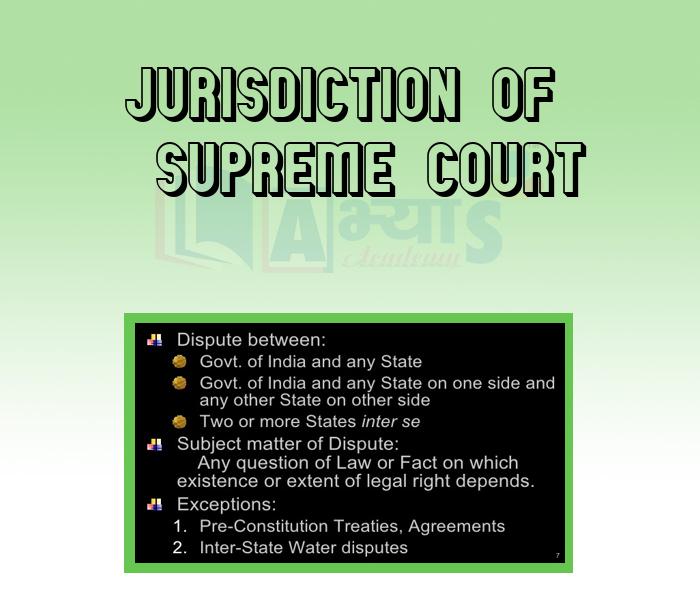Jurisdiction of Supreme Court











Jurisdiction of Supreme Court
Jurisdiction or Powers and Functions of the Supreme Court:
(1) Original Jurisdiction
(2) Appellate Jurisdiction
(3) Advisory Jurisdiction
1. Absolute or Original Jurisdiction
It is when a case directly goes to the Supreme Court. It has exclusive original jurisdiction over any dispute between the Government of India and one or more States, or between the Government of India and any State or States on one side and one or more States on the other, or between two or more States,
Which of the following are correct : (a) The Supreme Court has appellate jurisdiction under Article-139. (b) The Supreme Court is the highest appellate court in the India. (c) Article 136 of the Constitution states that the Supreme Court at its discretion may grant special leave for appeal against any decision, decree, sentence or order given by the court or tribunal in India. | |||
| Right Option : B | |||
| View Explanation | |||
In which of the following article, Supreme Court has appellate jurisdiction is mentioned ? | |||
| Right Option : B | |||
| View Explanation | |||
Which of the following are correct : (a) The Supreme Court of India enjoys advisory power which is available to the US Supreme Court. (b) Like India, the Upper House of the British Parliament i.e the House of Lords is the last appellate court in Britain. | |||
| Right Option : D | |||
| View Explanation | |||
Students / Parents Reviews [10]
It has a great methodology. Students here can get analysis to their test quickly.We can learn easily through PPTs and the testing methods are good. We know that where we have to practice

Barkha Arora
10thAbhyas Methodology is very good. It is based on according to student and each child manages accordingly to its properly. Methodology has improved the abilities of students to shine them in future.

Manish Kumar
10thIt was good as the experience because as we had come here we had been improved in a such envirnment created here.Extra is taught which is beneficial for future.

Eshan Arora
8thI have spent a wonderful time in Abhyas academy. It has made my reasoning more apt, English more stronger and Maths an interesting subject for me. It has given me a habbit of self studying

Yatharthi Sharma
10thA marvelous experience with Abhyas. I am glad to share that my ward has achieved more than enough at the Ambala ABHYAS centre. Years have passed on and more and more he has gained. May the centre flourish and develop day by day by the grace of God.

Archit Segal
7thMy experience with Abhyas academy is very good. I did not think that my every subject coming here will be so strong. The main thing is that the online tests had made me learn here more things.

Hiya Gupta
8thAbout Abhyas metholodology the teachers are very nice and hardworking toward students.The Centre Head Mrs Anu Sethi is also a brilliant teacher.Abhyas has taught me how to overcome problems and has always taken my doubts and suppoeted me.

Shreya Shrivastava
8thAbhyas is a complete education Institute. Here extreme care is taken by teacher with the help of regular exam. Extra classes also conducted by the institute, if the student is weak.

Om Umang
10thIt was a good experience with Abhyas Academy. I even faced problems in starting but slowly and steadily overcomed. Especially reasoning classes helped me a lot.

Cheshta
10thBeing a parent, I saw my daughter improvement in her studies by seeing a good result in all day to day compititive exam TMO, NSO, IEO etc and as well as studies. I have got a fruitful result from my daughter.
